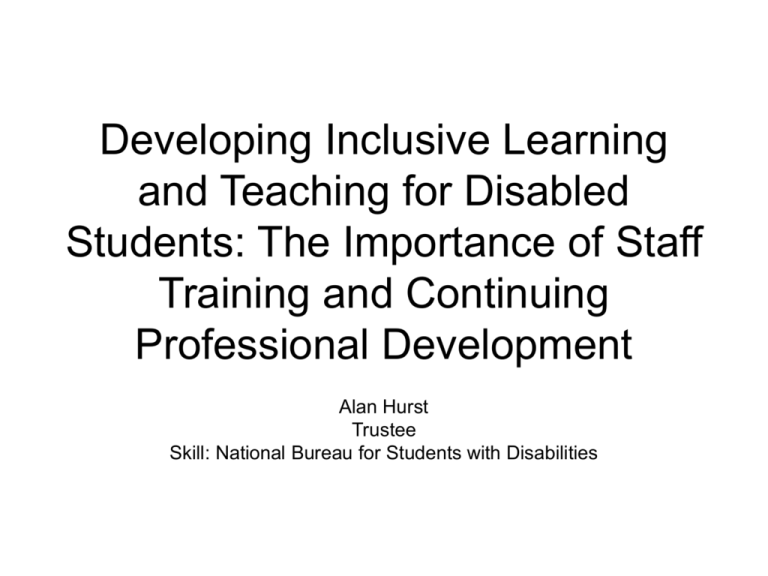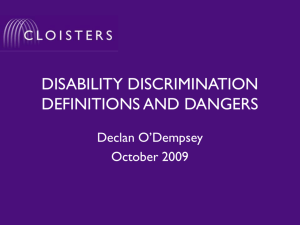Staff Training and Continuing Professional Development
advertisement

Developing Inclusive Learning and Teaching for Disabled Students: The Importance of Staff Training and Continuing Professional Development Alan Hurst Trustee Skill: National Bureau for Students with Disabilities Plan of Presentation • Evidence and themes emerging from the research • Some questions concerning staff training and development Evidence and Themes in the Research • Curriculum design • Learning, teaching and assessment • Institutional policies and provision • Individual/personal concerns Curriculum Design • The content of courses • The flexibility of courses • The requirements of professional bodies and fitness to practice • The maintaining of standards • The inclusion of placements and practical work • The possibilities offered by e-learning Learning, Teaching and Assessment • Provision of lecture notes in advance • Use of Powerpoint • Lectures as a teaching and learning strategy • Use of approaches which demonstrate principles associated with effective learning • Wide range of possible strategies not used The Institutional Context • Internal organisation and the administrative structure • The physical environment • Health and safety issues • The setting of priorities • The approach to staff training and continuing professional development Individual and Personal Factors • Knowledge of impairments and their potential impact on studying • Knowledge of assistive technology and “reasonable adjustments” • Lack of prior experience of working with students with a particular impairment • Lack of time Some questions concerning staff training and development • Who should deliver? • Who should receive? • When should it occur? • How should it be accomplished? • What should it include? Debating Terminology • Disability awareness? • Disability training? • Disability Education? • Equality or equity? Who should deliver? • Involvement of disabled people (linked to the Disability Discrimination Act 2005) • Role of mainstream staff developers • The contribution of specialist disability services staff Who should receive? • All staff • Targetted groups • Strategic approach with line managers • What about students? When should it occur? • Before initial contact with students with impairments • After some experience of working with students with impairments • Continuous and with some incentive to become involved How should it be accomplished? • Electronic self taught • Face-to-face sessions • Application of principles associated with effective learning • Use of simulations • Embedding into routine policies and provision • Compulsion or choice? Training: Some Sample Things to Do 1 • Learning is based on knowledge of basic principles – example – introducing medical and social models of disability • Learning develops confidence – example – ideas inventory (word association) • Learning improves knowledge – using a true/false questionnaire • Learning is based on real life situationsexample - using case studies of students Training: Some Sample Things to Do 2 • Learning is effective when relevance/usefulness seen –approaches to teaching students with dyslexia • Learning is effective if the approach is varied – using dvd/video/publications and publicity • Learning is effective when it is enjoyable – using cartoons for example by Callahan Some Potentially Positive Developments in 2009 Revision of the Quality Assurance Agency Code of Practice: Section 3 Students with Disabilities – to be used on regular visits to check on quality after September 2009 Review of Higher Education Funding Council for England policies on disability between 19972007 – has the funding given to support policy and provision for disabled students been used effectively? Closing Comments • No HEI which can claim to have implemented and embedded a successful, effective programme of initial disability education and continuing professional development • No HEI where disability services seen as valueadded provision rather than an optional, additional source of institutional expense









